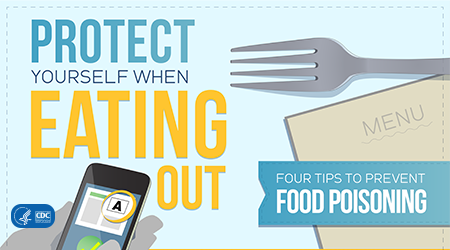Keep Food Safe
Following four simple steps at home — Clean, Separate, Cook, and Chill — can help protect you and your loved ones from food poisoning.
CLEAN: Wash your hands and surfaces often.
- Germs that cause food poisoning can survive in many places and spread around your kitchen.
- Wash hands for 20 seconds with soap and water before, during, and after preparing food and before eating.
- Wash your utensils, cutting boards, and countertops with hot, soapy water.
- Rinse fresh fruits and vegetables under running water.

SEPARATE: Don’t cross-contaminate.
- Raw meat, poultry, seafood, and eggs can spread germs to ready-to-eat foods—unless you keep them separate.
- Use separate cutting boards and plates for raw meat, poultry, and seafood.
- When grocery shopping, keep raw meat, poultry, seafood, and their juices away from other foods.
- Keep raw meat, poultry, seafood, and eggs separate from all other foods in the fridge.

COOK: To the right temperature.
- Food is safely cooked when the internal temperature gets high enough to kill germs that can make you sick. The only way to tell if food is safely cooked is to use a food thermometer. You can’t tell if food is safely cooked by checking its color and texture.
- Use a food thermometer to ensure foods are cooked to a safe internal temperature. Check this chart for a detailed list of foods and temperatures.
- 145°F for whole cuts of beef, pork, veal, and lamb (then allow the meat to rest for 3 minutes before carving or eating)
- 160°F for ground meats, such as beef and pork
- 165°F for all poultry, including ground chicken and turkey
- 165°F for leftovers and casseroles

CHILL: Refrigerate promptly.
Bacteria can multiply rapidly if left at room temperature or in the “Danger Zone” between 40°F and 140°F. Never leave perishable food out for more than 2 hours.
- Keep your refrigerator below 40°F and know when to throw food out.
- Refrigerate perishable food within 2 hours. (If outdoor temperature is above 90°F, refrigerate within 1 hour.)
- Thaw frozen food safely in the refrigerator, in cold water, or in the microwave. Never thaw foods on the counter, because bacteria multiply quickly in the parts of the food that reach room temperature.
Learn More Food Safety Tips
Related Links
- Foodborne Germs and Illnesses
- CDC food safety feature articles with more tips on preventing food poisoning
- Page last reviewed: July 21, 2017
- Page last updated: August 31, 2017
- Content source:


 ShareCompartir
ShareCompartir

